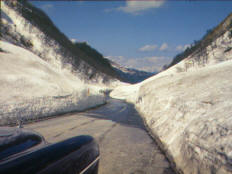We crossed back into Italy at Fernetti, near Trieste, without
incident. Before leaving Yugoslavia, however, we cashed in our surplus gas
coupons. (We had bought 400 liters but only used 200.) We also bought some
vinjak and slivovitz. At Udine we had trouble finding an open Esso station and
had to drive into the city (instead of using the bypass) to get gas. We had
pizza for lunch in Tolmezzo, much to the boys delight.

Snow in the Ploecken Pass
|
We took the same route back as we had used coming. There was
much less snow in the Ploecken Pass after a week of mild weather, but it was
still three or four feet deep along the road. We ran into heavy traffic in Munich, but
otherwise it wasn't bad. We had supper at the EES (PX) snack bar near the
Augsburg turnoff. It was 21:15 when we reached home, only 11½ hours from the time
we left Postonja. We'd driven 840 kilometers (520 miles) today. It had been a
hard day, and we all were glad to be home.
Total mileage for the trip was 3360 kilometers (about 2080
miles). We spent about $460 for travel expenses (about $7.70 a day per person),
plus another $60 for souvenirs and other things we bought.
Observations. This was a truly fascinating trip.
Even our sons agreed. However, the "forbidden fruit" aspect of visiting a
Communist county turned out to be nonexistent. Except for the slight delay at
the Yugoslav border and an occasional red star, we saw nothing that reminded us
of communism on the whole trip. Free enterprise seemed to be thriving as much as
anywhere in Western Europe.
The entire Dalmatian Coast was both beautiful and interesting.
Dubrovnik was a special treat. Yet, with their strong Roman and Venetian
flavors, they really didn't feel unfamiliar to us. But once we left the Adriatic
Coast and headed up the Neretva Valley, it was a strange new world. We had never
seen a mosque before, nor, as far as we knew, a Muslim. This trip was a
wonderful opportunity to learn a little about the Ottoman conquest and
occupation of this corner of Europe and the Muslim population they left behind.
While in Bosnia-Herzegovina, we concentrated so much on the
Muslims, though, that we probably failed to give adequate attention to the
Orthodox Christians there, who were almost as unfamiliar to us. We spent two
Sundays in Yugoslavia, but both were in predominantly Catholic areas where we could
attend the familiar Catholic Mass. We did visit the Serbian Orthodox Cathedral
in Sarajevo, and we found it very interesting. That was our first time in any
Orthodox church.
We were also greatly impressed by the successful melding of
Yugoslavia's disparate populations under Tito. Consequently, we were amazed when
the country disintegrated after Tito's death and completely shocked by the
subsequent internal wars, especially the Bosnian Civil War (1992-1995).
Page 1
2
3
4
5
6
7
8
9
10
11
[public_html/Travels/borderbottom.htm]